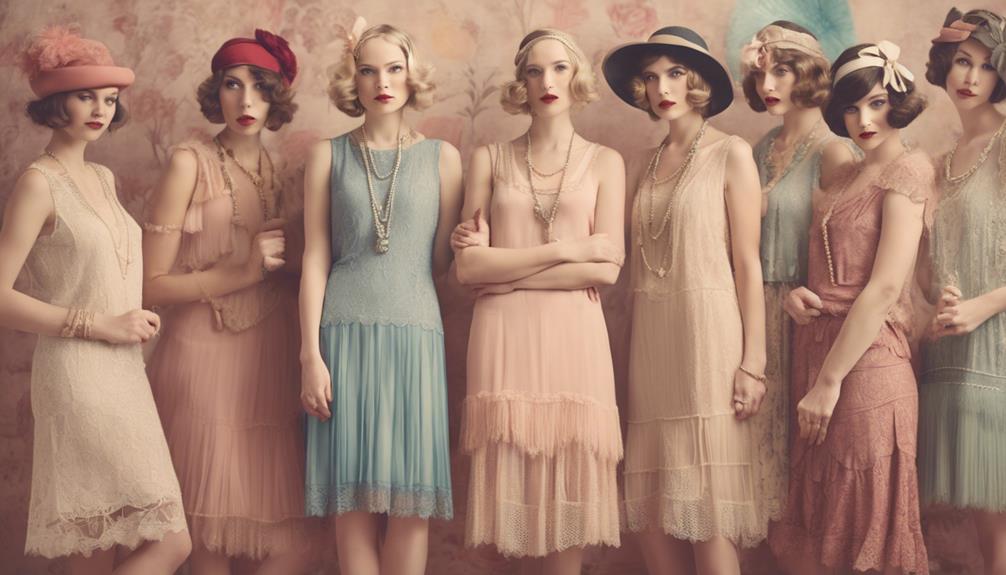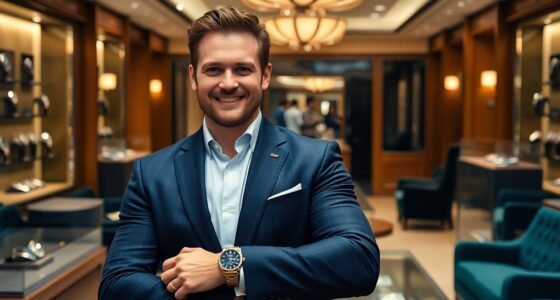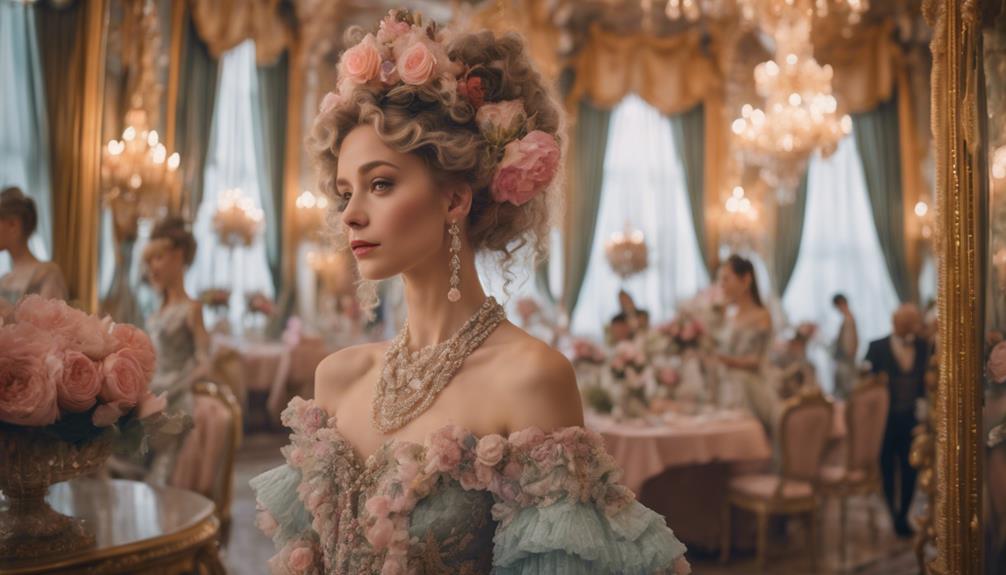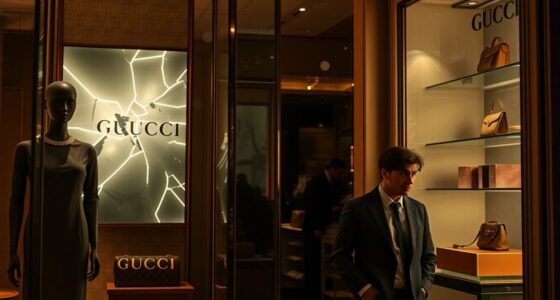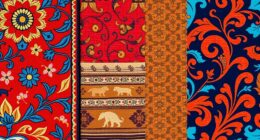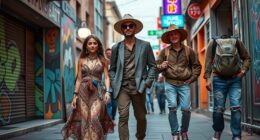The vibrant styles of the 1880s blend luxurious silk fabrics, intricate beadwork, and playful fringe into timeless elegance. This era reflects significant social change, paving the way for modern fashion trends. You'll find pastel hues and relaxed silhouettes that mirror today's quest for comfort and individuality. Designers like Coco Chanel popularized flapper dresses, emphasizing freedom in women's fashion. Today, you can see 1880s influences in vintage-inspired collections, rich with personality and flair. Get ready to explore how these classic looks can elevate your wardrobe and understand their cultural significance a little more.
Key Takeaways
- The 1880s introduced vibrant silk fabrics, fringe, and beadwork, setting the foundation for timeless fashion trends that continue to inspire today.
- Key characteristics included pastel hues and luxurious designs, emphasizing elegance while paving the way for more relaxed, practical styles in women's fashion.
- Influential figures like Coco Chanel reshaped women's fashion, promoting comfort and androgynous silhouettes that are still celebrated in contemporary styles.
- The era's fashion mirrored significant societal changes, reflecting women's evolving roles and fostering a spirit of independence and self-expression.
Origin and historical background of the fashion trend/style
When you think about the fashion of the 1880s, consider how it set the stage for future trends like the flapper dresses of the 1920s.
This era marked significant shifts in women's roles, paralleling the rise of jazz and the fight for liberation.
Understanding these connections helps you appreciate how 1880s fashion influenced the styles that followed.
Flapper Dresses' Cultural Significance
Flapper dresses symbolize a pivotal moment in fashion history, embodying women's liberation and the cultural upheaval of the 1920s. Emerging during the Jazz Age, these dresses featured loose fits, dropped waistlines, and knee-length hemlines, reflecting a shift towards relaxed and practical styles. As women gained the right to vote and began participating more actively in public life, flapper fashion became a visual representation of this cultural shift.
Iconic figures like Coco Chanel and Zelda Fitzgerald helped popularize the flapper look, marked by bold accessories, bobbed hairstyles, and an androgynous aesthetic that challenged traditional femininity. The flapper dress often showcased striking embellishments like sequins and fringe, allowing for movement and embodying the lively spirit of the era's dance culture, especially the Charleston.
This fashion trend didn't just represent a change in clothing; it also signified a broader societal transformation. Today, flapper dresses remain an enduring symbol of the Roaring Twenties and the evolution of women's fashion, reminding us of the spirit of freedom and individuality that defined the era. Through these garments, you can see the roots of modern women's liberation taking shape.
Jazz Age and Women's Liberation
The Jazz Age marked a transformative era where women boldly challenged societal norms, leading to a fashion revolution that emphasized freedom and individuality. This period, also known as the Roaring Twenties, saw the rise of the Flapper, a symbol of independence and a shift in women's fashion. With shorter hemlines and looser silhouettes, Flapper dresses embodied a new spirit of liberation, allowing women to express their personal style like never before.
Influential designers such as Coco Chanel played a vital role, promoting an androgynous look that prioritized comfort and simplicity. The bobbed hairstyle became another hallmark of this movement, symbolizing a break from restrictive norms. As women embraced fashion trends like the cloche hat and the flapper dress, they aligned with broader movements for women's rights, including the suffrage movement, which achieved a significant milestone with the ratification of the 19th Amendment in 1920.
The Jazz Age didn't just change what women wore; it paved the way for future generations to embrace their individuality and self-expression, solidifying its lasting impact on the fashion industry.
Key Characteristics
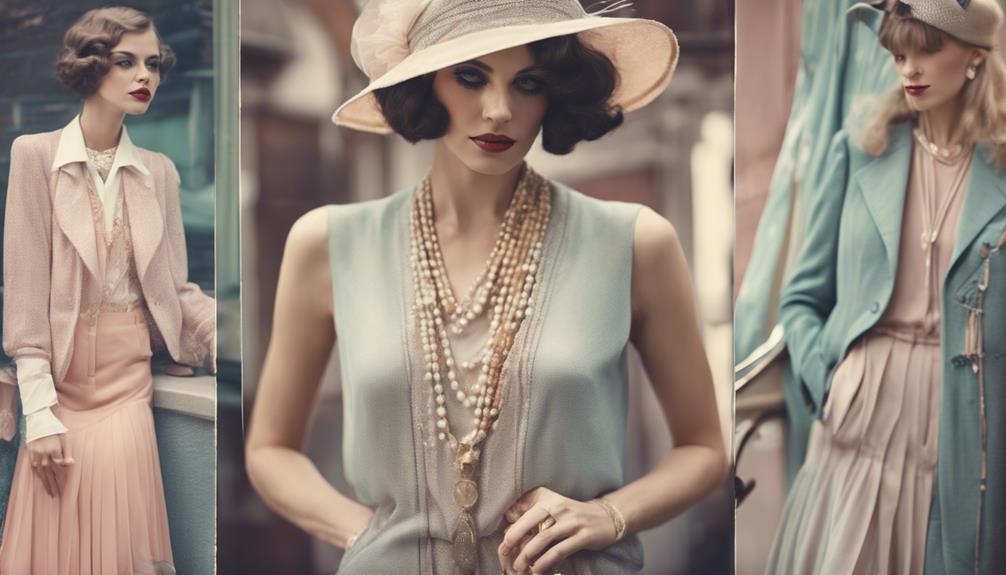
In the 1880s, you'll notice key characteristics that defined the era's fashion.
From vibrant silk fabrics to eye-catching fringe and beaded embellishments, these styles showcased a flair for elegance.
You'll also see pastel hues and fringe-trimmed cocktail dresses that added a playful yet sophisticated touch to women's wardrobes.
Fringe and Beaded Embellishments
Fringe and beaded embellishments add texture and visual interest to garments, making them stand out in any fashion era. You'll find that fringe embellishments first rose to prominence in the 1920s, bringing movement and a playful touch to flapper dresses amidst the vibrant Jazz Age.
As fashion history evolved, beaded embellishments gained traction in the 1930s and 1940s, infusing evening wear with luxurious glamour, heavily influenced by Hollywood's Golden Age.
Fast forward to the 1960s and 1970s, and you'll see fringe re-emerging in bohemian styles, championed by designers like Yves Saint Laurent. This trend symbolized counterculture and artistic expression, showcasing how timeless style can adapt to societal shifts.
The intricate craftsmanship behind beaded embellishments, ranging from simple patterns to elaborate motifs, highlights the attention to detail that elevates any outfit.
Today, both fringe and beaded embellishments continue to inspire contemporary fashion, appearing in high-end designer collections as well as accessible fast fashion. This cyclical nature of style proves that these embellishments remain relevant, ensuring your wardrobe can always reflect a rich blend of past and present influences.
Silk, Sequins, and Pastel Hues
Silk, sequins, and pastel hues create an enchanting trio that defines elegance and sophistication in fashion, often seen in stunning evening wear.
This luxurious combination has deep roots in fashion history, dating back to the glamorous 1920s and 1950s. You'll find silk, with its soft texture and radiant sheen, elevating evening gowns and blouses, making them feel effortlessly chic.
Sequins add a layer of sparkle, turning any outfit into a showstopper. They became particularly popular during the flapper era, where they adorned dresses that celebrated life's festivities. When you think of a night out, sequins are likely to come to mind, embodying the glamour and excitement of special occasions.
Pastel hues, including delicate shades like mint green, baby pink, and soft lavender, contribute to the overall aesthetic. These colors evoke feelings of spring and femininity, enhancing the elegance of silk and sequins.
Together, these elements create a timeless appeal that continues to inspire contemporary designers. So, when you choose garments that feature silk, sequins, and pastel hues, you're embracing a legacy of luxury that celebrates beauty and sophistication.
Fringe-Trimmed Cocktail Dresses
Cocktail dresses trimmed with fringe showcase an enchanting blend of movement and elegance, making them a striking choice for any social occasion. Inspired by the flapper style of the 1920s, these dresses emphasize freedom of movement, allowing you to dance with grace and confidence. The key characteristics of fringe-trimmed cocktail dresses include a fitted bodice that accentuates your figure, paired with a flared or straight skirt that often falls to knee-length or mid-calf. This design creates a sophisticated silhouette that's perfect for various events.
The fringes, typically crafted from luxurious materials like silk or chiffon, add texture and visual interest, catching the light as you move. This dynamic effect not only enhances your outfit but also evokes the glamour of the Jazz Age, making it a favorite for nights out.
Contemporary versions of these dresses maintain the classic allure of vintage designs while incorporating modern fabrics and cuts, ensuring you look stylish and timeless. Whether you're attending a cocktail party or a wedding, fringe-trimmed cocktail dresses are sure to make a memorable impression, merging historical charm with today's fashion sensibilities.
Modern Interpretation

When you look at today's fashion scene, you'll notice a vibrant resurgence of vintage-inspired styles, especially from the 1880s.
Designers are reimagining classic silhouettes, like the flapper dress, with modern twists that appeal to your sense of style.
Influential figures from the Roaring Twenties continue to inspire contemporary designs, blending past and present in exciting ways.
Vintage-Inspired Fashion Resurgence
There's been a remarkable resurgence in vintage-inspired fashion, as modern designers breathe new life into classic styles from past decades. You'll find that elements from the 1920s to the 1990s are making a comeback, with designers blending modern fabrics and prints with traditional silhouettes. This fusion creates looks that are both classic and timeless.
What's exciting about vintage-inspired fashion is how it emphasizes individuality and personal expression. You can curate outfits that reflect your unique style, steering away from the conformity of mass-produced clothing. Whether you're drawn to the flapper dresses of the 1920s or the bohemian vibes of the 1970s, there's something for everyone.
The rise of sustainable fashion also plays a significant role in this resurgence. Embracing thrifted items and upcycled pieces allows you to make environmentally conscious choices while expressing your style. Modern reinterpretations often include contemporary embellishments and innovative cuts, ensuring that these vintage styles feel fresh and relevant.
Contemporary Flapper Dress Designers
Contemporary designers are reimagining the flapper dress, infusing it with modern flair while preserving its iconic silhouette. Brands like Gucci and Valentino are leading the charge, using modern fabrics and embellishments to create pieces that resonate with today's fashion-savvy consumers. You'll find that many modern adaptations feature intricate beadwork and fringe details reminiscent of the 1920s, combined with contemporary elements like asymmetrical hemlines and bold color palettes.
Sustainable fashion is also making its mark, with eco-friendly brands crafting flapper-inspired dresses that prioritize ethical production. This reflects the growing demand for responsible fashion choices among consumers like you.
If you're looking for accessible options, online retailers like ASOS and ModCloth offer affordable variations of the flapper dress, ensuring that this vintage aesthetic is within reach for a wider audience.
The resurgence of vintage fashion trends has sparked renewed interest in flapper styles, with these dresses frequently appearing on red carpets and in popular culture, showcasing their enduring appeal. Whether you're dressing for a special occasion or just want to channel that classic vibe, contemporary flapper dresses have something for everyone.
Fashion Icons of the Roaring Twenties
Fashion icons of the Roaring Twenties, like Coco Chanel and Zelda Fitzgerald, continue to inspire today's designers with their bold looks and revolutionary spirit. The flapper style they championed, marked by short hemlines and bobbed hair, celebrates liberation and individuality, which resonates in modern fashion.
You'll notice that contemporary designs often feature the iconic little black dress, a timeless staple introduced by Chanel. This piece is versatile and remains a go-to for countless occasions. Additionally, bold patterns and vibrant colors from the 1920s are reimagined in today's collections, showcasing a fusion of vintage inspiration and modern aesthetics.
Accessories play a significant role too. Cloche hats, long pearl necklaces, and T-strap shoes are making comebacks, adding a nostalgic touch to current outfits. Designers blend these timeless styles with contemporary fabrics, creating looks that are both relevant and stylish.
As you explore today's fashion landscape, remember the powerful influence of these early fashion icons. Their spirit of innovation and self-expression continues to shape modern wardrobes, proving that great style is indeed timeless.
Styling Tips
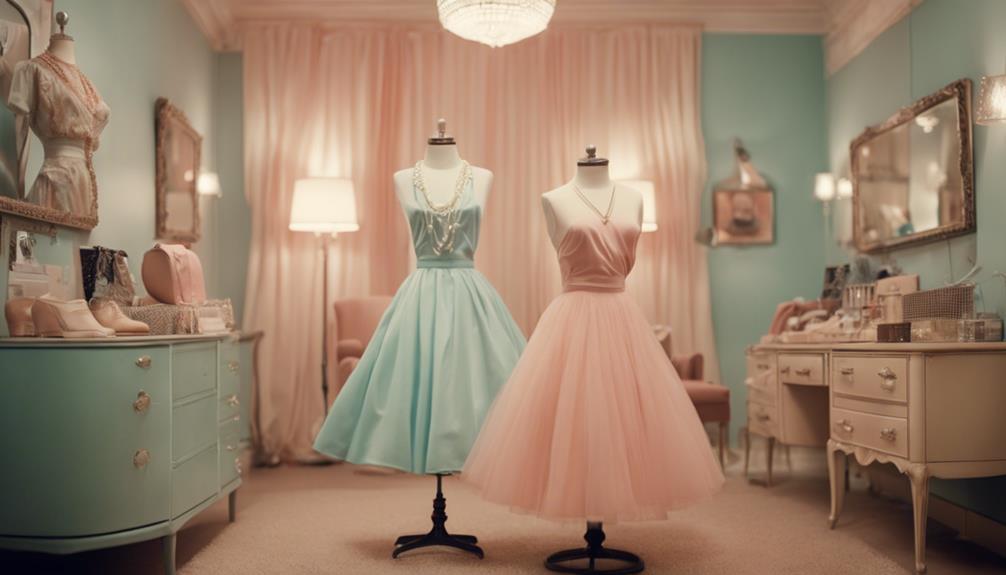
When it comes to styling your outfits with an 1880s flair, don't underestimate the power of fringe-trimmed accessories.
Pairing a fringe cocktail dress with modern silhouettes can create a striking contrast that's both chic and nostalgic.
Fringe-Trimmed Accessories
Fringe-trimmed accessories can instantly elevate your outfit, adding a playful touch that works for both casual outings and formal events. These fringe accessories, inspired by vintage styles from the 1920s flapper era and the bohemian looks of the 1970s, bring a dynamic flair to your wardrobe.
To style these pieces effectively, start by pairing them with solid colors. This allows the fringe detail to shine as a statement piece, drawing attention without overwhelming your look.
Consider layering fringe-trimmed items with different textures, like denim or leather, to create a visually interesting contrast that enhances your overall outfit.
When selecting your fringe accessories, always opt for quality materials. Well-crafted pieces not only guarantee durability but also elevate even the simplest outfits.
A high-quality fringe bag or scarf can transform your look, making it feel more polished and intentional.
Fringe-Trimmed Cocktail Dress Pairings
How can you elevate your look with a fringe-trimmed cocktail dress? Start by pairing it with strappy heeled sandals. This combination not only highlights the movement of the fringe but also creates an elegant silhouette perfect for evening events.
To add structure to your outfit, consider layering your dress with a tailored blazer or a cropped leather jacket. This chic contrast enhances the flowing fringe while maintaining a polished look.
When it comes to accessorizing, opt for statement earrings or a bold cuff bracelet. These pieces will draw attention to your neckline and amplify the glam of your fringe dress. Choose a clutch in a solid color that complements your dress—this keeps the focus on the texture of the fringe without overwhelming your ensemble.
For a playful twist, why not style your cocktail dress with a wide-brimmed hat or a feathered fascinator? These accessories infuse a vintage flair reminiscent of the 1920s flapper era, making your outfit truly stand out.
With these tips, you'll effortlessly become the center of attention at any event!
Fringe With Modern Silhouettes
Incorporating fringe with modern silhouettes can effortlessly transform your outfit into a stylish statement. To achieve this, consider pairing fringe details with tailored pieces like a fitted blazer or sleek trousers. This combination creates a dynamic contrast that elevates your look while maintaining a contemporary edge.
You can also introduce fringe through accessories, such as bags or shoes, which adds a playful element without overwhelming your overall design. If you opt for fringe tops, balance them with clean lines, like a pencil skirt, to guarantee the playful texture complements a sophisticated silhouette.
For a more layered approach, try a fringed jacket over a minimalist dress. This not only showcases both retro and modern influences but also keeps your outfit stylish and balanced.
When styling fringe with modern silhouettes, focus on neutral colors. This strategy helps maintain versatility, allowing the fringe to serve as the statement piece without clashing with other elements in your outfit.
Shopping Guide
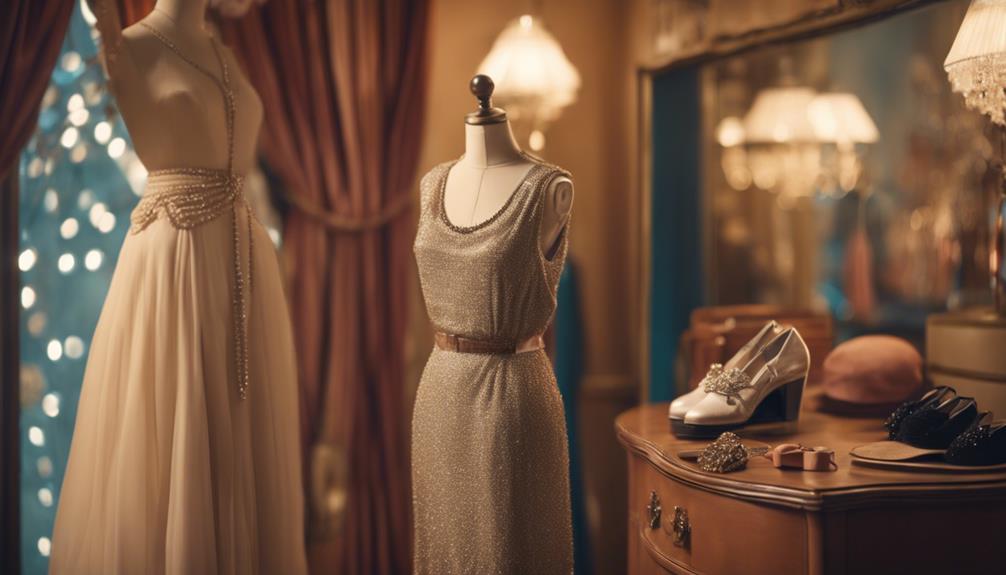
When you're shopping for timeless 1880s-inspired styles, focus on classic pieces that transcend trends, like trench coats and button-down shirts. These items have remained essential in fashion for decades and can form the backbone of a versatile wardrobe.
Consider investing in high-quality, durable clothing that aligns with sustainable fashion principles, ensuring you make fewer purchases over time.
Explore vintage shops or thrift stores to uncover unique pieces that reflect the charm of past eras. These finds not only offer distinct styles but also promote sustainable fashion practices by reducing waste.
Don't forget to look for contemporary designers who reinterpret classic silhouettes with modern fabrics and prints, allowing you to enjoy a fresh look while maintaining that timeless essence.
Incorporating versatile items into your wardrobe is key. Choose pieces that can be dressed up or down, enabling seamless shifts between casual and formal settings.
This approach not only keeps your style timeless but also helps you navigate ever-changing fashion trends with ease.
Embrace the art of curating a collection that celebrates both the past and present, ensuring your wardrobe remains stylish and sustainable.
Fringe Embellishment Techniques
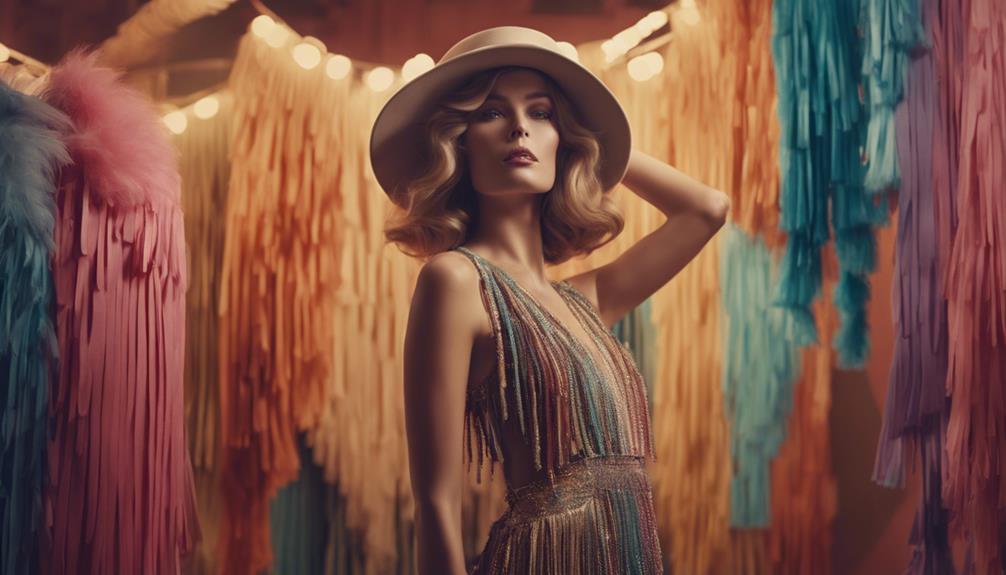
When you think about adding a unique touch to your outfits, fringe embellishment projects can really elevate your style.
You can explore various fringe techniques for personalization, making your garments truly one-of-a-kind.
Let's look at how you can incorporate fringe into your wardrobe effectively.
Fringe Embellishment Projects
Fringe embellishments can transform your garments into eye-catching pieces by adding movement and texture that enhance their overall style. When you incorporate fringe into your fashion design projects, you draw from vintage inspiration while creating contemporary fashion statements.
Start by selecting your preferred materials—whether it's leather for a bold look, cotton for a classic feel, or synthetic fibers for versatility. Cut the fabric into strips, and attach them to your clothing or accessories, letting the fringe flow beautifully. You can customize the design by experimenting with knotting, beading, or layering techniques to elevate the traditional fringe appearance.
Consider applying fringe to a simple dress, jacket, or even a handbag to add a playful touch. This approach not only showcases your creativity but also allows you to make unique fashion statements that stand out.
Fringe embellishments are perfect for festival wear, evening gowns, or casual outfits, making them a versatile addition to your wardrobe. Don't hesitate to explore different styles and lengths of fringe to find the perfect look that resonates with your personal aesthetic. Embrace the charm of fringe and watch your pieces come to life!
Fringe Techniques for Personalization
Incorporating various fringe techniques allows you to personalize your garments, giving them a unique flair that reflects your individual style. Fringe embellishment adds dynamic textures and movement, making your outfits visually appealing and distinctive. You can explore different fringe techniques to achieve the look you desire.
For instance, cut fringe creates a playful tassel effect, while twisted fringe offers an intricate, sophisticated touch. You can sew fringe directly onto the hem of your garments for a bold statement or incorporate it into accessories like bags and jackets for added interest. Hats adorned with fringe can also bring a playful, bohemian vibe to your ensemble.
Experiment with different materials, such as leather, cotton, or synthetic fibers, to match your designs and aesthetic preferences. The resurgence of fringe in contemporary fashion allows you to revisit the styles of the 1920s and 1970s while making them your own.
Cultural Impact
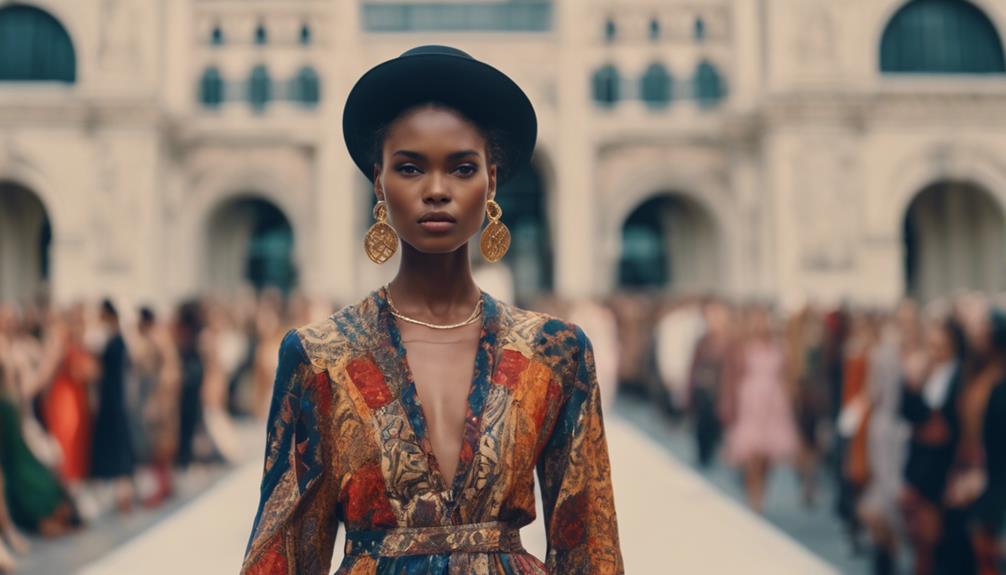
When you look at the cultural impact of fashion from the 1880s, it's clear that styles often mirrored the societal changes happening at the time.
For instance, the flapper fashion that emerged in films later reflects the growing influence of the women's suffrage movement.
This connection between clothing and social movements shows how fashion can be a powerful tool for expressing cultural values.
Flapper Fashion in Films
How did flapper fashion shape the portrayal of women in films during the Roaring Twenties, transforming both cinema and societal perceptions of gender roles?
Flapper fashion, with its short hemlines, bobbed hairstyles, and loose-fitting garments, became a powerful symbol of female empowerment in films like 'The Great Gatsby' and 'Chicago.' These movies showcased characters who embodied the liberated spirit of the era, challenging traditional norms and expectations.
Costume designers such as Edith Head and Travis Banton played significant roles in bringing flapper aesthetics to life on screen. Their work not only enhanced visual storytelling but also influenced fashion trends beyond the silver screen. The portrayal of flappers in cinema helped cement the idea of women as independent and modern, reflecting broader cultural shifts in gender roles and societal expectations.
The cultural impact of flapper fashion continues to resonate today, inspiring contemporary designers and fashion enthusiasts alike. As you watch films that revive this style, you can appreciate how flapper fashion not only transformed the film industry but also contributed to a lasting legacy of female empowerment in society.
Women's Suffrage Movement Influence
The Women's Suffrage Movement transformed women's fashion by promoting practical clothing that reflected their quest for freedom and equality. As women fought for their rights, they shifted from restrictive corsets to looser silhouettes that allowed for greater movement and comfort. This change marked a significant departure from traditional norms, paving the way for a new era in women's fashion.
Suffragists often wore white dresses during marches to symbolize purity and draw attention to their cause. They embraced tailored suits, which challenged gender norms and represented empowerment in both society and the workplace. Iconic figures like Susan B. Anthony and Emmeline Pankhurst showcased styles that blended functionality and femininity, influencing countless women to adopt a more assertive fashion identity.
The cultural impact of the suffrage movement led to lasting changes in women's fashion. It emphasized the importance of comfort and mobility, ultimately contributing to the evolution of modern women's wear. Today, you can see echoes of this movement in contemporary styles that prioritize practicality while celebrating women's empowerment.
Frequently Asked Questions
What Fashion Style Is Timeless?
Timeless fashion styles include classic pieces like tailored blazers and little black dresses. You'll find that these enduring looks adapt to trends yet maintain their elegance, ensuring you'll always look stylish, no matter the decade.
What Were 4 Fashion Styles of the 1970s?
In the 1970s, you'd see Bohemian Chic with flowing fabrics, Disco fashion featuring glittery outfits, Punk style embracing rebellious DIY looks, and the Polyester Era showcasing leisure suits and bold colors. Each style reflected unique cultural moments.
What Are the Fashion Eras in Order?
To understand fashion eras in order, you'll start with the 1900s, then move to the 1920s, followed by the 1930s, the 1940s, and finally the 1950s, each showcasing unique styles and influences.
What Is the History of Classic Fashion Style?
Classic fashion style evolved through the 20th century, showcasing influences from the flapper era to the miniskirt revolution. You'll find timeless pieces like the little black dress remain essential in today's wardrobe.
How Do 1880s and 1920s Fashion Styles Differ and Similar?
The fashion styles of the 1880s and 1920s differ in several ways. The 1880s were characterized by structured silhouettes and conservative designs, while the timeless 1920s fashion styles embraced a more liberated and relaxed look with straight lines, dropped waists, and shorter hemlines. Despite these differences, both eras showcased elegance and sophistication in their own unique ways.
Conclusion
Incorporating 1880s fashion into your wardrobe can bring a unique flair to your style. With its rich history and distinct characteristics, you can easily blend vintage elements with modern trends.
Whether you're looking to add fringe embellishments or simply channel the era's elegance, there's something for everyone.
So, embrace these timeless styles, experiment with your look, and let the spirit of the 1880s inspire you to create outfits that stand out in today's fashion landscape!
